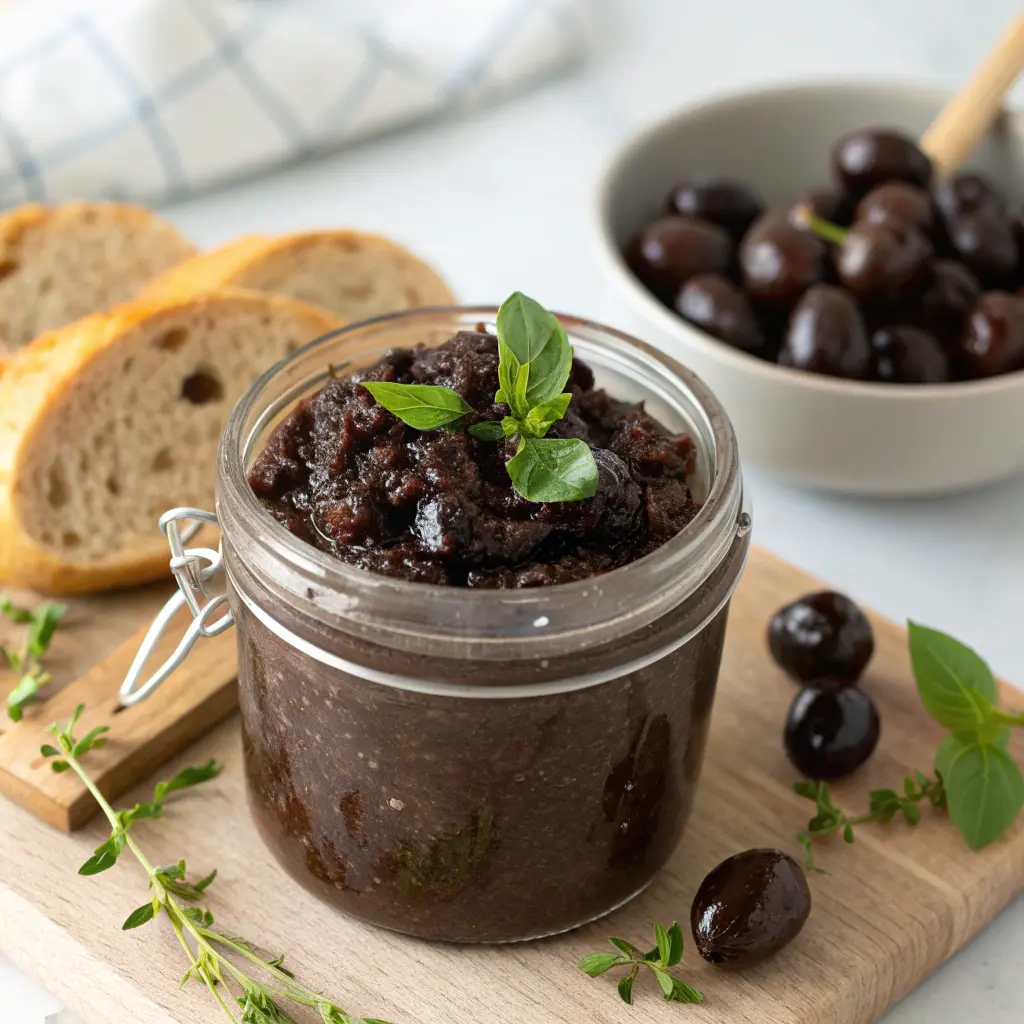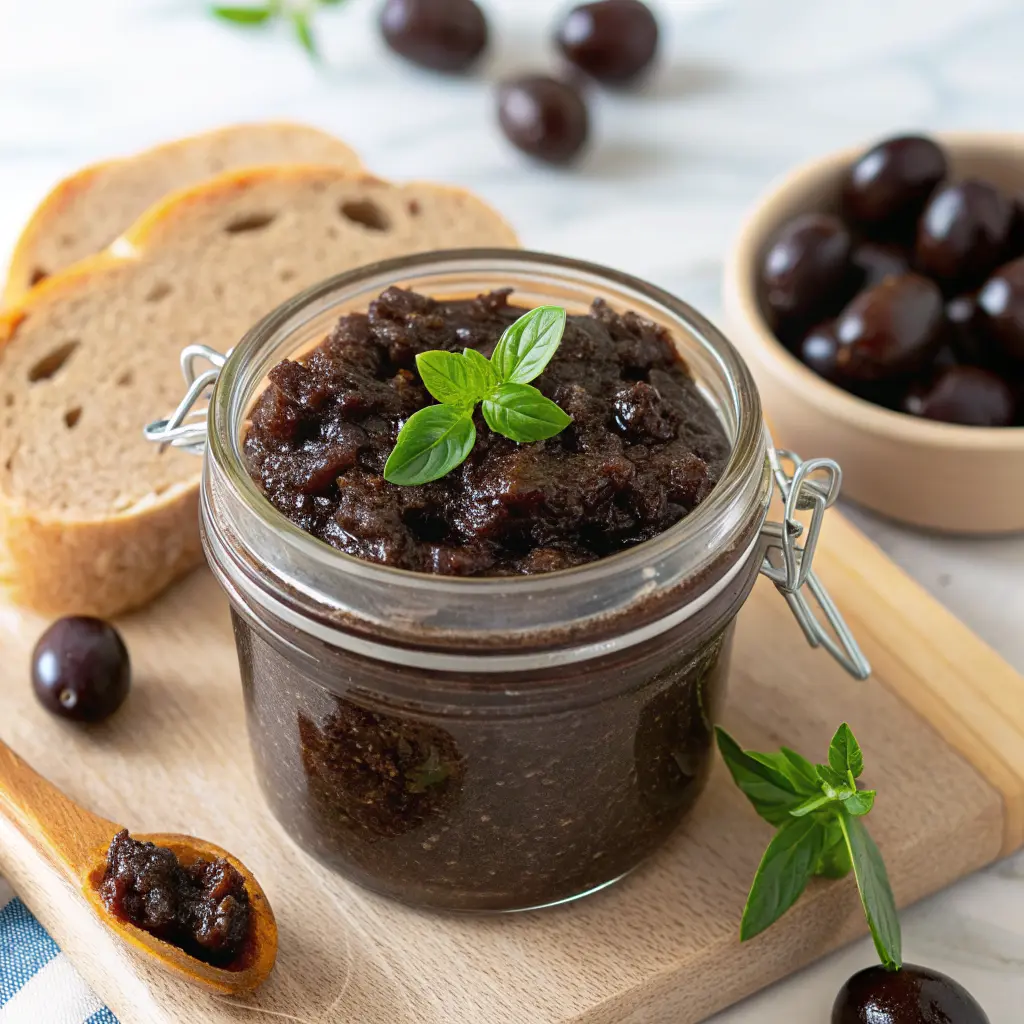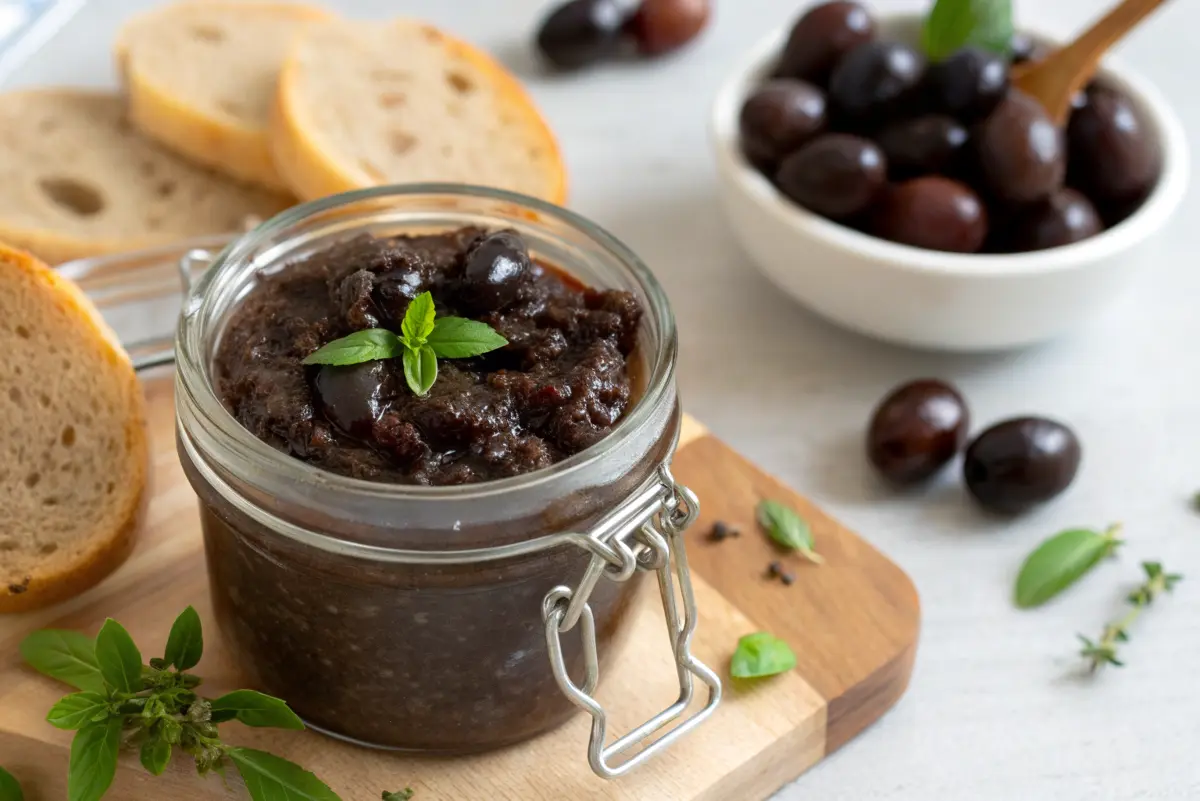Meet Mediterranean Olive Tapenade—the briny, sun-kissed olive spread that turns simple food into instant “wow.” Built on a base of finely chopped olives, bright capers, mellow garlic, and silky extra-virgin olive oil, this classic Provençal staple is all about balance: salty, aromatic, and citrus-lifted. Spoon it onto crostini, swirl it through warm pasta, or dollop it over grilled vegetables and fish—one small jar unlocks a week of effortless flavor.
For a concise origin snapshot of tapenade and what traditionally goes into it, skim the tapenade origin and definition.
What Is Tapenade?
At its simplest, tapenade is a Provençal olive and caper spread enriched with olive oil—often with anchovies and garlic. The texture ranges from finely chopped to luxuriously spreadable, depending on whether you use a chef’s knife, a mortar and pestle, or a food processor. The result is intensely savory, complex, and endlessly flexible.
Ingredient Deep-Dive: Building Bold, Balanced Flavor
Olives (Your Foundation)
- Black Olives (e.g., Niçoise, Kalamata): Deep, winey, rich—classic for black olive tapenade.
- Green Olives (e.g., Castelvetrano, Picholine): Brighter and sometimes buttery; great for green olive tapenade.
- Curing & Flavor: Brine-cured olives bring clean salinity; salt-cured olives skew intense and pleasantly bitter; oil-cured olives feel lush and concentrated.
- Pro tip: Mix varieties. A 70/30 blend (black/green) often hits that sweet spot of depth + freshness.
Capers (The Namesake Signal)
- Provide a lemon-pickle vibe that punctuates every bite.
- Salt-packed capers are complex but need a quick rinse; brined capers are friendlier out of the jar.
Anchovies (Classic—but Optional)
- Tiny dose, huge payoff. They melt into the background and add that indescribable “why is this so good?” note.
- Prefer fillets packed in oil; drain and pat dry.
- If skipping anchovies, try umami substitutes (see below).
Garlic, Citrus, and Herbs
- Garlic: A little raw garlic is powerful; microplane for even dispersion.
- Lemon Zest & Juice: Balances salt and fattiness; add at the end so it stays bright.
- Herbs: Parsley is classic; thyme, basil, or oregano fit beautifully.
Extra-Virgin Olive Oil (Your Emulsifier)
- Adds body and gloss, carrying aromatics across the palate.
- Choose a balanced oil—assertive but not harsh.

Choosing the Right Olives (Flavor Profiles You Can Taste)
- Kalamata: Fruity, wine-cured, distinctly Mediterranean; fabulous for crostini and pasta.
- Niçoise/Le Cailletier: Small, herbal, slightly bitter—quintessential Provençal character.
- Castelvetrano: Buttery, mellow, and green—perfect for a gentler tapenade or for green versions.
- Picholine: Crisp, briny, and bright; lovely for a perkier profile.
Mix & Match Ideas
- Bistro-style: 60% black + 40% green (Kalamata + Castelvetrano).
- Provencal classic: 80% Niçoise + 20% green for lift.
- Picnic-friendly: Mostly green with a handful of black for depth.
Gear & Methods (Knife, Mortar, or Processor?)
Knife-Chopped (Rustic & Defined)
- Best texture control; each ingredient keeps its character.
- Perfect when serving on boards or as a topping where definition matters.
Mortar & Pestle (Traditional & Luxurious)
- Gently bruises and emulsifies, resulting in a plush, cohesive spread.
- Great for smaller batches and ceremony—adds romance to the process.
Food Processor (Fast & Convenient)
- Ideal for larger batches.
- Pulse in short bursts to avoid a paste; you want spreadable with tiny, visible flecks.
The Master Ratio (Memorizable & Forgiving)
Start with this flexible baseline and tweak to taste:
- 3 parts olives (pitted, well-drained)
- 1 part capers (rinsed)
- ½–1 part extra-virgin olive oil (enough to bind)
- 1–2 small anchovy fillets (optional)
- 1 small garlic clove (micro-planed or very finely minced)
- Fine zest of ½ lemon + 1–2 tsp lemon juice
- Herbs to finish (parsley; thyme/oregano as accents)
- Black pepper to taste
Step-by-Step: Foolproof Mediterranean Olive Tapenade
- Prep Ingredients
- Pit olives (if needed). Rinse capers (especially if salt-packed). Pat everything dry so the texture isn’t watery.
- Start the Base
- On a board or in a mortar, combine olives, capers, garlic, and anchovy (if using). If using a processor, add to the bowl.
- Chop or Pulse
- Knife/Mortar: Chop or pound to a coarse rubble.
- Processor: Pulse in short bursts; scrape sides often. Aim for a fine chop with visible pieces—not a baby-food smooth paste.
- Emulsify with Oil
- Drizzle in extra-virgin olive oil, stirring or pulsing until it glistens and just holds.
- Season & Brighten
- Add lemon zest and juice, black pepper, and herbs. Taste—adjust salt only if necessary (capers and anchovies add a lot already).
- Rest
- Let it sit 20–30 minutes (or overnight) so flavors marry. The briny seams relax; the citrus floats to the top notes.

Make-Ahead, Storage & Handling
- Short Rest = Better Flavor: A brief chill lets the capers, aromatics, and oil integrate.
- Storage: Spoon into a clean jar and smooth the surface. Float a thin oil cap on top to slow oxidation.
- Fridge Window: Enjoy within several days for peak aroma and texture.
- Freezing: Portion into silicone cubes or small jars. Thaw gently in the fridge and re-stir with a splash of fresh oil and a squeeze of lemon.
Troubleshooting & Pro Tips
- Too Salty: Rinse ingredients thoroughly next time. To fix now, fold in chopped parsley, unsalted nuts (almonds/walnuts), or a bit more olive. Brighten with lemon.
- Too Bitter: Switch to a different olive variety, add a touch of lemon, and confirm your oil is fresh.
- Too Oily: Pulse in more olives, roasted red pepper, or a spoon of almonds/walnuts for body.
- Too Dense: Whisk in a teaspoon of olive oil or a splash of caper brine to loosen.
- Flat Flavor: Add a little more lemon zest, a pinch of black pepper, or a few thyme leaves.
- Over-Processed: Stir in a handful of hand-chopped olives for texture rescue.
Chef’s Micro-Tips
- Microplane the garlic to distribute flavor evenly without harsh chunks.
- Add lemon zest at the end to keep the top-note aroma vivid.
- For crostini, brush bread with olive oil and lightly toast it so the tapenade doesn’t get soggy.
Serving Ideas & Pairings
Boards & Bites
- Crostini with tapenade + shaved Parmesan + parsley.
- Crackers and crudités platters.
- Cheese boards: pair with triple-cream, fresh mozzarella, ricotta, or young goat cheese.
Sandwiches & Wraps
- Spread inside baguettes or ciabatta with tomato, arugula, and roasted peppers.
- Turkey or vegetable panini with a thin swipe of tapenade + provolone.
- Breakfast toast with soft-cooked eggs and a dab of tapenade (trust the combo!).
Pasta, Grains & Veg
- Toss with warm spaghetti and a spoonful of pasta water, finish with lemon zest.
- Fold into farro or couscous salads with cherry tomatoes and cucumbers.
- Spoon over grilled zucchini, roasted eggplant, or blistered peppers.
Fish, Chicken & Beyond
- Whisk into pan drippings as an instant finishing sauce.
- Top roasted or grilled fish; spoon alongside roast chicken.
- Stir into mayo or yogurt-based dips for a quick aioli-style spread.
Wine & Beverage Pairings
- Crisp whites (Vermentino, Picpoul, Sauvignon Blanc) and dry rosé match the brine and citrus.
- Sparkling water with lemon peel and a green olive—simple and perfect with the snacky vibe.
FAQ — People Also Ask
What is tapenade made of?
A blend of olives (black or green), capers, extra-virgin olive oil, and often anchovies and garlic. Lemon zest/juice and fresh herbs finish the flavor.
Is tapenade French or Mediterranean?
Both, in a sense. The classic is Provençal (southern France), but olive pastes appear all around the Mediterranean.
Which olives are best for tapenade?
For classic depth: Niçoise or Kalamata. For a gentler, buttery style: Castelvetrano. Picholine adds bright brininess. Mixing varieties yields complexity.
Can I make tapenade without anchovies?
Absolutely. Replace anchovy umami with a dab of white miso, a pinch of nori flakes, or simply lean more on caper brine and lemon.
Do I need capers?
They’re core to the classic. If you must substitute, use a splash of caper brine, a few chopped pickled peppers, or green peppercorns for tang.

